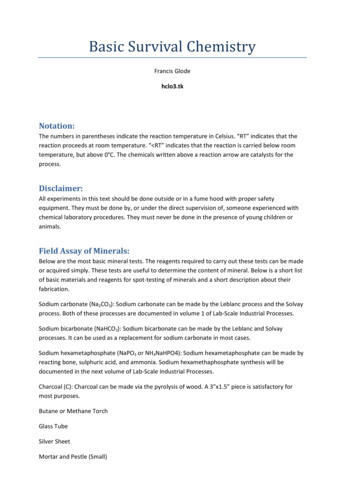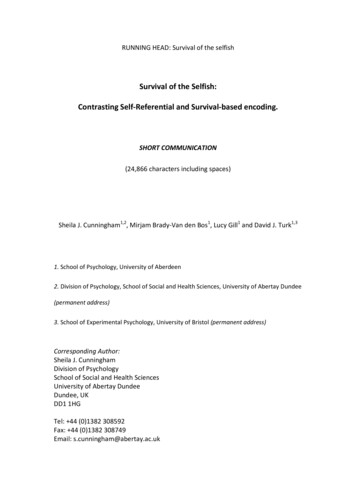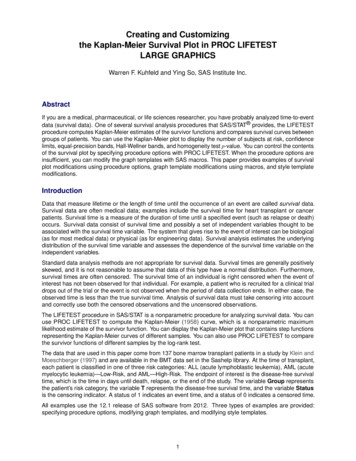
Transcription
Basic Survival ChemistryFrancis Glodehclo3.tkNotation:The numbers in parentheses indicate the reaction temperature in Celsius. “RT” indicates that thereaction proceeds at room temperature. “ RT” indicates that the reaction is carried below roomtemperature, but above 0 C. The chemicals written above a reaction arrow are catalysts for theprocess.Disclaimer:All experiments in this text should be done outside or in a fume hood with proper safetyequipment. They must be done by, or under the direct supervision of, someone experienced withchemical laboratory procedures. They must never be done in the presence of young children oranimals.Field Assay of Minerals:Below are the most basic mineral tests. The reagents required to carry out these tests can be madeor acquired simply. These tests are useful to determine the content of mineral. Below is a short listof basic materials and reagents for spot-testing of minerals and a short description about theirfabrication.Sodium carbonate (Na2CO3): Sodium carbonate can be made by the Leblanc process and the Solvayprocess. Both of these processes are documented in volume 1 of Lab-Scale Industrial Processes.Sodium bicarbonate (NaHCO3): Sodium bicarbonate can be made by the Leblanc and Solvayprocesses. It can be used as a replacement for sodium carbonate in most cases.Sodium hexametaphosphate (NaPO3 or NH4NaHPO4): Sodium hexametaphosphate can be made byreacting bone, sulphuric acid, and ammonia. Sodium hexamethaphosphate synthesis will bedocumented in the next volume of Lab-Scale Industrial Processes.Charcoal (C): Charcoal can be made via the pyrolysis of wood. A 3”x1.5” piece is satisfactory formost purposes.Butane or Methane TorchGlass TubeSilver SheetMortar and Pestle (Small)
Test for Sulphide, Selenide, and Tellurides:In this test, a small amount of mineral powder is mixed with sodium carbonate and melted oncharcoal. When in reducing, basic conditions, all sulphates, selenates, and tellurates will be reducedto sodium sulphide, sodium selenide, and sodium telluride, respectively. A pinch of this melt isadded on silver, and a drop of water added. A black stain will develop if any sulphur, tellurium orselenium was present in the mineral.The Open Glass Tube Test:In this test, a sample of mineral is heated in an open 25o Glass tube. The glass tube has an insidediameter of about ¼” (7 mm) and a length of about a foot (30 cm). The glass tube must have oneside parallel to the ground, and the other side pointing up. The idea is that the hot gases rising inthe tube will draw in fresh oxygen. A sample of the mineral is put in the glass tube, near the bend.The sample is heated, and the results noted. A metallic coating in the tube that turns to small beadswhen rubbed indicates a mercury-bearing mineral. If a white, crystalline ring is formed where thetube is cold, an arsenic-bearing mineral is present. The oxidized material can be analysed in thephosphate bead test.Test for Transition Metal Ions:The phosphate bead test is a test for transition metals ions. It consists of heating an amount ofsodium hexametaphosphate on a nickel or platinum wire loop, and when the “bead” is melted, asmall amount of the mineral powder is added, and the bead is heated again. The bead may beheated in an oxidizing or a reducing flame. When the bed is in the flame, it is in a reducingenvironment. When the bed is over the flame, it is in an oxidizing environment.Oxidizing flameHotVery paleyellowVery paleyellowVery paleyellowVery paleyellowYellowYellowYellowYellowishgreenDeep yellowto brownishredYellow todeep yellowReddish tobrownish redGreenColdColorlessAmount ofmaterialMuchChemicalsElementsTa, CdColorlessMuchPb, Sb, BiReducing flameHotColdVery wnColorlessMediumWDirty blueFine orlessPale y paleyellowishgreenPale dirtygreenDirty greenYellow toalmostcolorlessYellowMedium tomuchFeLittle tomediumLittle tomediumVRed, yellow,to yellowishgreenDirty greenAlmostcolorless tovioletFine grayNiReddish tobrownish redLittleCuPale yellowishgreenYellow toreddishyellowPale blue,nearlyYellow toreddishyellowRather paleblueFine greenFine green
colorless, attime ruby redOpaque redDark greenBlueMediumCuDirty greenFine greenCrBlueBlueCoBlueBlueGrayish violetPale roseVioletPale roseLittle tomediumLittle tomediumMediumMuchBrownishgreenDirty greenMnNdColorlessPale roseColorlessPale roseFine greenCompounds:Mercury (II) sulfide (HgS): Mercury (II) sulfide is found as the rare mineral cinnabar, a red powder. Itis insoluble in water and very easily bought. It is used as a vermillion pigment.Calcium carbonate (CaCO3): Calcium carbonate is found as seashells, marble, limestone, and manyother minerals. It is insoluble and extremely common. It can be found mostly everywhere aslimestone using the acid test. In this test, a small piece of rock is dissolved in acid. If off-gassingoccurs, it may indicate carbonate. If, upon addition of a soluble sulfate salt, a white precipitate isformed, it probably indicate the presence of calcium. This compound is white to gray in color.Basic lead carbonate (Pb2CO3(OH)2): Formerly used as a pigment, this compound is also known as“white lead”, and can be made easily by reacting lead in a acetic acid and CO2 atmosphere, withoutdirect contact with the acetic acid. This compound is white.Lead orthoplumbate (Pb3O4): Commonly referred to as “red lead”, this compound is a powerfuloxidizing agent that is generally used in dry state for fusion, or used as a very versatile oxidizer inmany solid-state reactions needing oxygen. This compound is orange to red in color.Acetic acid (CH3COOH): Commonly referred to as “vinegar”, it is commonly available in a range ofconcentrations from 5 to 10%, but 99% acetic acid is also sold as glacial acetic acid, and can bemade by dry distillation of sodium acetate and sulfuric acid or a bisulfate salt.Sulfuric acid (H2SO4): Sulfuric acid is an oily, clear liquid with very strong acidic properties whenpure, and is commonly used as a battery acid. Most sulphuric acid is diluted, and must beconcentrated by heating to 300 degree Celsius in glass or enameled equipment. This compound isvery dangerous when pure, so take precautions.Iron (IV) disulfide (FeS2): This compound is commonly found as the mineral “pyrite”, also known as“fools’ gold”. It is very easily found in nature as cubic crystals with a metallic luster. This compoundis metallic gray to yellow in color.Iron (II) sulfide (FeS): This is produced by the reduction of sulfur with iron and by the thermaldecomposition of pyrite. It can be used to make hydrogen sulfide. It is black in color, and ispyrophoric when finely powdered.Sodium carbonate (Na2CO3): Sodium carbonate is commonly used as a base and as a drying agent. Itcan replace sodium hydroxide in the majority of the cases. This compound is white.Sodium chloride (NaCl): Sodium chloride is commonly referred to as “salt”. Deposits of thiscompound are found as halite crystals, and an impure form can be obtained by evaporating seawater. This compound is also used as a facile source of chloride ions. This compound is white.
Mercury (Hg): Also known as “quicksilver”, this noble metal occurs very rarely in nature via theoxidation of cinnabar deposits. It is primarily made from cinnabar, its main ore. It is a very densemetal, heavier than lead, and is very expensive. This element is gray, metallic liquid.Chlorine (Cl2): Chlorine is a toxic, yellow gas that is deadly in high concentrations. In lowerconcentrations, it is much less dangerous, and has been linked to liver and dental damage inchronic contact. This compound is the most used synthetic oxidizing agent.Manganese dioxide (MnO2): Quite common as its mineral pyrolusite, this compound is a very stableoxidising agent, with low health risks due to being highly insoluble. It is extremely prone to staining.This compound is commonly found in alkaline batteries. This compound is black, and reacts withHCl to produce chlorine gas.Sulfur dioxide (SO2): Sulfur dioxide is an asphyxiating gas with reducing properties. It can be used asa direct precursor to sulphuric acid.Carbon (C): Carbon can be easily made via the pyrolysis of wood. It is the cheapest reducing agentand is a very useful fuel to heat reactions. In the usual method of production, a wood pile is set upwith good air access, and when the fire is going, dirt is piled around so that there is one inlet nearthe ground and one outlet on the top. After a few hours, the dirt is searched for charcoal. Thiscompound is black.Calcium oxide/ Calcium hydroxide (CaO/Ca(OH)2): These are the most commonly used bases inindustry, because they are very cheap and easily made. The usual method is via a lime kiln. Bothcompounds are white powders.Calcium hypochlorite (Ca(OCl)2): This compound is commonly found as a source of “chlorine” forpools. It is a strong oxidizing agent, is stable, and is not prone to decomposition. This compound iswhite.Bases:CaCO3 CaO CO2 (800 C)CaO H2O Ca(OH)2 (RT)Na2SO4 4C CaCO3 Na2CO3 4CO CaS (900 C)Acids:4FeS2 15O2 4 H2O 8H2SO4 2Fe2O3 (500 C)2NaCl H2SO4 Na2SO4 2HCl (100 C)3NO2 H2O 2HNO3 NO ( RT)2H2O O2 2SO2 2H2SO4 (RT)2SO2 O2 2SO3 (500 C)Oxidizers:4HCl O2 2Cl2 2H2O (400 C)2Cl2 2Ca(OH)2 CaCl2 Ca(OCl)2 2H2O (RT)
4HCl MnO2 MnCl2 Cl2 2H2O (50 C)2MnCl2 2Ca(OH)2 O2 2MnO2 2CaCl2 2H2O (RT)3Pb2CO3(OH)2 O2 2Pb3O4 3CO2 3H2O (375 C)Reducers:CxH2xOx xC x H2O (600 C)6C 2O2 Fe2O3 2Fe 6CO2 (600-1600 C)SO2 Na2CO3 Na2SO3 CO2 (RT)Miscellaneous:HgS Fe FeS Hg (600 C)HgS O2 SO2 Hg (500 C)CaC2 N2 CaCN2 C (1100 C)CaCN2 3H2O 2NH3 CaCO3 (100 C)
Conclusion:Survival chemistry is mostly based on natural resources. Some may not be avaible in your country; assuch it may be interesting to read on exploited mineral, and all mineral found in your country. Most ofthese experiments can be done in enameled steel, glass or bare iron. Judgement applies. Iron is only forbases and reducing agent, glass is for low temp acid or neutral reaction as well as oxidizers andenameled is for high temp acid reaction. High temperature reaction needs hardwood charcoal andcompressed air for heating.Thanks to:Francisco Gomez (Vargouille) for the complete revision of this document
Basic Survival Chemistry Francis Glode hclo3.tk Notation: The numbers in parentheses indicate the reaction temperature in Celsius. "RT" indicates that the reaction proceeds at room temperature. " RT" indicates that the reaction is carried below room temperature, but above 0 C. The chemicals written above a reaction arrow are catalysts .









![[ST] Survival Analysis - Stata](/img/33/st.jpg)

